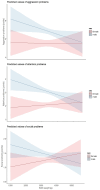Sex-specific effects of birth weight on longitudinal behavioural outcomes in children and adolescents: findings from the raine study
- PMID: 38722568
- PMCID: PMC11618204
- DOI: 10.1007/s00787-024-02450-6
Sex-specific effects of birth weight on longitudinal behavioural outcomes in children and adolescents: findings from the raine study
Abstract
Previous cross-sectional studies suggest that birth weight (BW) is associated with aggression-, social- and attention problems differently in boys and girls. We sought to test if these differences could be confirmed in a longitudinal study. The 1989 Raine Study provided prospectively collected data on perinatal variables and repeated child behaviour checklist assessments from ages 5 to 17. Linear mixed effects models provided crude and adjusted relationships between BW and childhood behaviour at a conservative significance threshold using prenatal maternal covariables in adjusted models. Sensitivity analyses included an age10 teacher assessment. Data on behaviour, BW and sex, was available in 2269 participants. Male sex was associated with increased aggression problems at lower BW compared to females in the crude model (Interaction B: -0.436, 98.3%CI: [-0.844, -0.0253]), but not the adjusted model (Interaction B: -0.310, 98.3%CI: [-0.742, 0.140]). Male sex was associated with increased attention problems at lower BW compared to females in both the crude model (Interaction B: -0.334, 98.3%CI: [-0.530, -0.137]) and the adjusted model (Interaction B: -0.274, 98.3%CI: [-0.507, -0.0432]). Male sex was associated with increased social problems at lower BW compared to females in both the crude model (Interaction B: -0.164, 98.3%CI: [-0.283, -0.0441]) and the adjusted model (Interaction B: -0.148, 98.3%CI: [-0.285, -0.00734]). Using repeated measures from ages 5-17 we were able to show a crude and adjusted male vulnerability to lower BW in the development of attention problems and social problems. We did not find a BW x sex interaction for the development of aggressive behaviour.
Keywords: Aggression Problems; Attention Problems; Birth weight; Child Behaviour Checklist; Longitudinal; Sex differences; Social Problems.
© 2024. The Author(s).
Conflict of interest statement
Declarations. Conflict of interest: The authors declare no conflicts of interest.
Figures

Similar articles
-
Sex-Specific Effects of Birth Weight on Longitudinal Behavioral Outcomes: A Mendelian Randomization Approach Using Polygenic Scores.Biol Psychiatry Glob Open Sci. 2024 Aug 26;4(6):100387. doi: 10.1016/j.bpsgos.2024.100387. eCollection 2024 Nov. Biol Psychiatry Glob Open Sci. 2024. PMID: 39483322 Free PMC article.
-
The longitudinal relationship between prenatal maternal cortisol and preschool internalising problems.Psychoneuroendocrinology. 2024 Oct;168:107141. doi: 10.1016/j.psyneuen.2024.107141. Epub 2024 Jul 17. Psychoneuroendocrinology. 2024. PMID: 39059226
-
Gender differences in behavioral and emotional problems among school children and adolescents in China: National survey findings from a comparative network perspective.J Affect Disord. 2025 Jan 15;369:227-233. doi: 10.1016/j.jad.2024.09.067. Epub 2024 Sep 14. J Affect Disord. 2025. PMID: 39284529
-
Maternal acetaminophen use during pregnancy and childhood behavioural problems: Discrepancies between mother- and teacher-reported outcomes.Paediatr Perinat Epidemiol. 2020 May;34(3):299-308. doi: 10.1111/ppe.12601. Epub 2019 Nov 6. Paediatr Perinat Epidemiol. 2020. PMID: 31693212 Free PMC article.
-
Mental health and behavioural problems in adolescents conceived after ART.Hum Reprod. 2022 Nov 24;37(12):2831-2844. doi: 10.1093/humrep/deac214. Hum Reprod. 2022. PMID: 36166695
References
-
- Bateson P et al (2004) Developmental plasticity and human health. Nature 430(6998):419–421 - PubMed
-
- de Loret C et al (2014) Low birth weight, preterm birth and small for gestational age association with adult depression: systematic review and meta-analysis. Br J Psychiatry 205(5):340–347 - PubMed
-
- Sømhovd MJ et al (2012) Anxiety in adolescents born preterm or with very low birthweight: a meta-analysis of case-control studies. Dev Med Child Neurol 54(11):988–994 - PubMed
-
- Franz AP et al (2018) Attention-Deficit/Hyperactivity disorder and very Preterm/Very low Birth Weight: a Meta-analysis. Pediatrics, 141(1) - PubMed
MeSH terms
LinkOut - more resources
Full Text Sources
Medical

